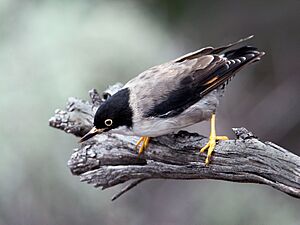Varied sittella facts for kids
Quick facts for kids Varied sittella |
|
|---|---|
 |
|
| Male | |
 |
|
| Female | |
| Conservation status | |
| Scientific classification | |
| Genus: |
Daphoenositta
|
| Species: |
chrysoptera
|
| Synonyms | |
|
Neositta chrysoptera |
|
The varied sittella (Daphoenositta chrysoptera) is a small songbird that lives in Australia. It is about 10 to 11 centimeters long. People also call it the Australian nuthatch, orange-winged sittella, or barkpecker.
Contents
Bird Names and Family
The varied sittella was first described by a scientist named John Latham in 1801. He gave it the scientific name Sitta chrysoptera.
The name Daphoenositta comes from old Greek words. Daphoinos means 'blood-red' or 'tawny'. Sittē is a bird like a woodpecker. The second part of its scientific name, chrysoptera, also comes from Greek. Khrusopteros means 'golden-winged'.
This bird lives in many different places. Its look changes depending on where it lives. That's why it's called the "varied" sittella! There are five main types, called subspecies:
- D. c. leucoptera - found in northwest to north-central Australia. It's known as the white-winged sittella.
- D. c. striata - lives in northeast Australia. This one is called the streaked sittella.
- D. c. leucocephala - found in eastern Australia. It's known as the white-headed sittella.
- D. c. chrysoptera - lives in southeast Australia. This is the orange-winged sittella.
- D. c. pileata - found in southwest, west-central, central, and south Australia. It's called the black-capped sittella.
What the Varied Sittella Looks Like
The top of its head, called the crown, can be white, grey, or black. Its body is usually whitish or grey. It often has black and grey stripes.
Its wings are black. They have a wide bar that can be white or cinnamon colored. The bird's eyes are dark orange. The skin around its eyes, its legs, and its feet are orange-yellow. Its beak is orange with a black tip. This black tip can reach all the way to the base of the beak.
The colors of the varied sittella depend completely on its subspecies. Sometimes, different subspecies can even have babies together. Scientists think that some of these subspecies might become their own separate species in the future.
How Varied Sittellas Behave
These birds often fly in groups. They look for food in trees of all sizes. They can climb down tree trunks headfirst, much like a nuthatch. They eat spiders and insects. They usually find these by pulling them out from under the tree bark.
Their calls are thin and high-pitched, sounding like chwit. When many birds call together, it becomes a louder, metallic sound like tchweit-tchweit-tchweit. They often call back and forth as they move from one tree to another.
Reproduction and Life Cycle
In spring and summer, larger groups of birds break up. They form smaller groups for breeding. These groups usually have a pair that will have babies. They also have other adult birds and younger birds from the year before.
The nest is shaped like a cone. It is made from bark, plant fibers, and spider webs. They build their nests 5 to 25 meters (about 16 to 82 feet) high. Nests are usually in the fork of a branch or on an open limb.
The female bird lays two or three white eggs with blue spots. Each egg is about 17 by 13 millimeters (0.67 by 0.51 inches). The female sits on the eggs for 18 to 20 days until they hatch.
Images for kids



